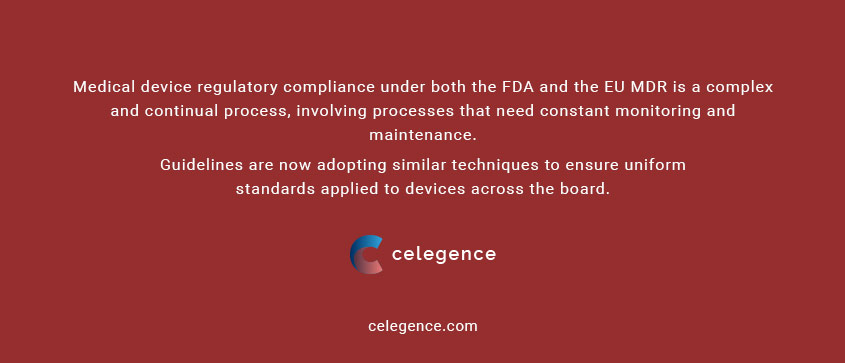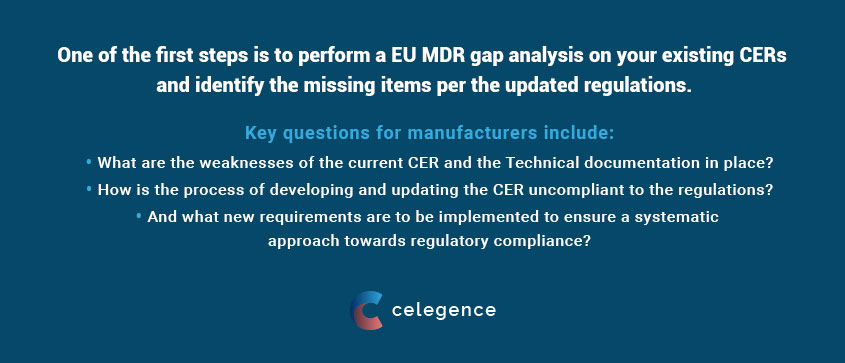
FDA Vs EU MDR – Medical Device Approvals
In order to receive a CE Mark in the European Union, device manufacturers must demonstrate compliance to one of the European Union’s Directives related to ‘medical’ products: the Medical Device Directive (93/42/EEC), the In-Vitro Diagnostic Medical Device Directive (98/79/EC), or the Active Implantable Medical Device directive (90/385/EEC). The articles listed in the directives correspond to claiming the safety and performance of the device. This aspect relies on the GSPRs listed, requiring manufacturers to demonstrate how their device, development program, and product manufacturing conforms to the associated GSPRs.
The regulatory strategy of medical device approvals in the North American region is usually defined by Section 510(k) of the Food, Drug, and Cosmetic Act from the Food and Drug Administration (FDA). The 510(k) pathway has allowed manufacturers to reach a large and single market, with minimal costs compared to the Premarket Approval (PMA).
The recent requirements of the new medical device regulations (MDR) are much closer to that of the FDA requirements in terms of prerequisites for the conformity assessment, the quality management system compliant with ISO 13485, and the conformity to harmonized standards such as IMDRF, IEC 62304, IEC 62366, and ISO 14971.

Difference Between Medical Device Approvals FDA vs EU MDR
Device Classification
The FDA’s classifications are based on the device’s risk. Class I and Class II devices are low and moderate-risk devices, regulated by the 510(k), and require manufacturers to demonstrate that the device functions similarly to a previously approved device. Higher risk devices – Class III, such as implantable devices, require a PMA with data demonstrating and validating the safety, performance, and overall risk-benefit assessment of the device.
The MDR, in contrast, has 4 categories of devices – non-invasive devices, invasive medical devices, active medical devices, and a special category that includes contraceptive, disinfectant, and radiological diagnostic medical devices. The risk-based classifications in the MDR are presented below and determine the depth of data and evaluation required.
- Class I – Non-sterile or no measuring function (low risk)
- Class I – Sterile and a measuring function (low/medium risk)
- Class IIa (medium risk)
- Class IIb (medium/high risk)
- Class III (high risk)
Risk Process
Per FDA requirements, Class I devices without a measuring function and are not sterilized, do not need to be audited. The manufacturer can self-declare and then place it on the market (with appropriate documentation). Class II and upwards require a 510(k) process thereby requiring a clinical testing protocol along with a Design History File (DHF). The multi-dimensional 510(k) submission includes the following evaluations:
- Preliminary safety testing
- Risk management processes – including risk estimation, hazard identification, and mitigation strategies
- Overall residual risk analysis and risk-benefit assessments
Manufacturers during the 510(k) process are also required to maintain and update a device master record (DMR) and ensure that the quality management system (QMS) in place is complying with the target markets.
Whereas under the MDR, most Class I and Class IIa devices with medium risk require conformity assessments based on Annex XI of the MDR (Part A). Class IIb and Class III devices require extensive technical documentation and extensive risk evaluation during the conformity assessments with notified bodies involving at least two audits. The first is a screening audit to review the QMS procedures and quality manual for compliance with ISO 13485 and the associated directives. The second is a Technical File review and a facility/certification audit, whereby QMS records and facilities are inspected. The period provided between these audits provides manufacturers time to generate management review/manufacturing documents, and including the CAPAs to demonstrate that the QMS in place is working.

Claim Your Free EU MDR Checklist Now!
Make sure you and your business are compliant with the new EU MDR. Get our 23 page checklist for actionable technical documentation requirements.
Documentation
At a minimum, the Technical File documentation for most regulatory processes includes a Risk Management Report, Design documentation, and Manufacturing documentation.
Both the FDA and the EU MDR require a design plan along with the supporting documentation, this includes the plan requirements, architecture, verification, and validation. Additionally, for CE marking, notified bodies will require a design manufacturing report along with any manufacturing validation activities to be completed before the certification audit. Finally, the Technical File submitted to the Notified Body must also contain a Clinical Evaluation Report which summarizes the review of data held by the manufacturers, a literature review of the device and/or equivalent devices, and a search from vigilance databases to identify known hazards and risks of using those devices.
Unique Device Identification (UDI)
The UDI is a series of numeric or alphanumeric characters that is created through a globally accepted device identification and coding standard system. It allows the unambiguous identification of a specific medical device on the market, increasing patient safety and helping to optimize patient care by setting up global standards.
In September of 2013, the FDA established a rule stating that a unique device identifier number should be assigned by the device manufacturer to each version or model of a device, and that the unique device identifier should be both in the human-readable format and in AutoID format.
The EU MDR adopted and refined the UDI requirements in 2017, introducing a new concept of the basic UDI-DI, which allows for the grouping of regulated medical devices within EUDAMED, the EU regulatory database for regulated medical devices. Other stipulations differing from FDA include that the UDI on labels and software need to be identical, and that the cleaning process for reusable devices is to be considered within the system.

Medical Device Compliance for FDA & EM MDR
Medical device regulatory compliance under both the FDA and the EU MDR is a complex and continual process, involving processes that need constant monitoring and maintenance. Guidelines are now adopting similar techniques to ensure uniform standards applied to devices across the board. For example, the movement of European guidelines to a stricter review and audit of not only the QMS, but also the product information, like the 510(k) processes by the FDA. Key areas of scrutiny under both regulations include; clinical data, product information, performance testing, labelling, benefit-risk assessments, residual risks, and post-market surveillance. Manufacturers must be abreast with the updating regulations to best comply with the submission requirements for their device’s regulatory system.

Claim Your Free EU MDR Checklist Now!
Make sure you and your business are compliant with the new EU MDR. Get our 23 page checklist for actionable technical documentation requirements.
FDA and EU MDR Compliance Specialists
Celegence offers design-oriented solution systems to help manufacturers navigate through the complex regulatory requirements set by the FDA and EU MDR. We can assist you throughout the entire process to ensure that you and your business are compliant with all FDA and EU MDR requirements.


